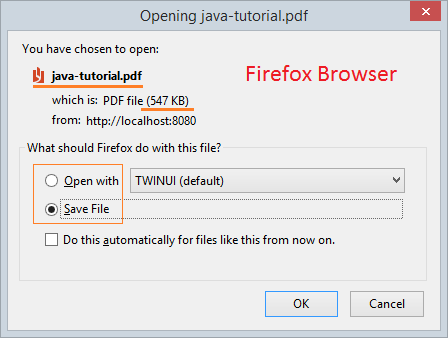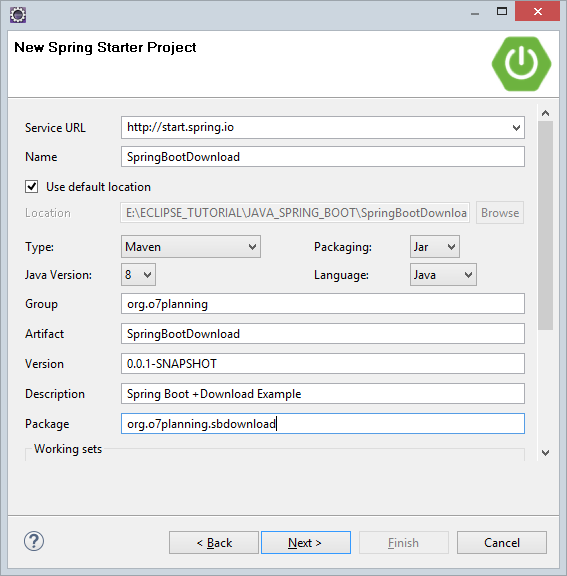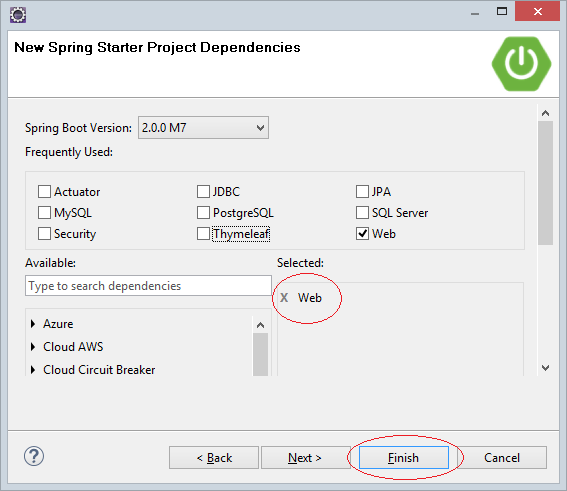Ví dụ Download file với Spring Boot
1. Mục tiêu của bài học
Trong bài học này tôi sẽ hướng dẫn bạn tạo một ứng dụng Spring Boot có các chức năng để download các tập tin từ Web Server về máy tính địa phương. Chẳng hạn các file ảnh, zip, pdf,...
Sau đây là một vài cách để tạo chức năng download tập tin:
- ResponseEntity<InputStreamResource>: Viết một phương thức trả về đối tượng ResponseEntity, đối tượng này bao lấy (wrap) một đối tượng InputStreamResource (Là dữ liệu của tập tin mà người dùng download về).
- ResponseEntity<ByteArrayResource>: Viết một phương thức trả về đối tượng ResponseEntity, đối tượng này bao lấy (wrap) một đối tượng ByteArrayResource (Là dữ liệu của tập tin mà người dùng download về).
- HttpServletRespone: Ghi trực tiếp dữ liệu của tập tin cần download vào HttpServletRespone.

Với các tập tin có kích thước lớn, người dùng khi download về cần phải đợi một khoảng thời gian. Có một vài thông tin sau bạn cần phải cung cấp cho trình duyệt:
Content-Disposition
Content-Disposition: Là một thông tin trên phần Header của Response, nó cho biết nội dung dự kiến sẽ được hiển thị trên trình duyệt.
- inline: nội dung sẽ hiển thị tự động.
- attachment: Tập tin đính kèm.
- form-data: Dữ liệu form.
- ....
Content-Disposition: inline
Content-Disposition: attachment
Content-Disposition: attachment; filename="java-tutorial.pdf"Content-Length
contentLength: Đây là kích thước của nội dung (Tính theo đơn vị byte). Thông tin này giúp cho trình duyệt thông báo với người dùng kích thước nội dung chuẩn bị download. Vì vậy trong khi download trình duyệt có thể thông báo cho người dùng số lượng byte đã download được, hiển thị phần trăm đã được download, ước lượng thời gian còn lại.
Content-Type
Thông tin này giúp trình duyệt biết được nội dung này có thể mở bằng các ứng dụng nào, và gợi ý người dùng mở bằng một chương trình có sẵn trên máy tính của họ khi nội dung đã download thành công. Sét đặt Content-Type=application/octet-stream nếu bạn muốn trình duyệt download nội dung đó lập tức, không cần hỏi người dùng.
Content-Type: application/octet-stream
Content-Disposition: attachment; filename="picture.png"
Content-Type: image/png
Content-Disposition: attachment; filename="picture.png"
Content-Type: image/png
Content-Disposition: inline; filename="picture.png"Xem thêm:
2. Tạo dự án Spring Boot


pom.xml
<?xml version="1.0" encoding="UTF-8"?>
<project xmlns="http://maven.apache.org/POM/4.0.0" xmlns:xsi="http://www.w3.org/2001/XMLSchema-instance"
xsi:schemaLocation="http://maven.apache.org/POM/4.0.0 http://maven.apache.org/xsd/maven-4.0.0.xsd">
<modelVersion>4.0.0</modelVersion>
<groupId>org.o7planning</groupId>
<artifactId>SpringBootDownload</artifactId>
<version>0.0.1-SNAPSHOT</version>
<packaging>jar</packaging>
<name>SpringBootDownload</name>
<description>Spring Boot +Download Example</description>
<parent>
<groupId>org.springframework.boot</groupId>
<artifactId>spring-boot-starter-parent</artifactId>
<version>2.0.0.RELEASE</version>
<relativePath/> <!-- lookup parent from repository -->
</parent>
<properties>
<project.build.sourceEncoding>UTF-8</project.build.sourceEncoding>
<project.reporting.outputEncoding>UTF-8</project.reporting.outputEncoding>
<java.version>1.8</java.version>
</properties>
<dependencies>
<dependency>
<groupId>org.springframework.boot</groupId>
<artifactId>spring-boot-starter-web</artifactId>
</dependency>
<dependency>
<groupId>org.springframework.boot</groupId>
<artifactId>spring-boot-starter-test</artifactId>
<scope>test</scope>
</dependency>
</dependencies>
<build>
<plugins>
<plugin>
<groupId>org.springframework.boot</groupId>
<artifactId>spring-boot-maven-plugin</artifactId>
</plugin>
</plugins>
</build>
</project>SpringBootDownloadApplication.java
package org.o7planning.sbdownload;
import org.springframework.boot.SpringApplication;
import org.springframework.boot.autoconfigure.SpringBootApplication;
@SpringBootApplication
public class SpringBootDownloadApplication {
public static void main(String[] args) {
SpringApplication.run(SpringBootDownloadApplication.class, args);
}
}3. ResponseEntity<InputStreamResource>
Viết một phương thức trả về đối tượng ResponseEntity, đối tượng này bao lấy (wrap) một đối tượng InputStreamResource (Là dữ liệu của tập tin mà người dùng download về).
Example1Controller.java
package org.o7planning.sbdownload.controller;
import java.io.File;
import java.io.FileInputStream;
import java.io.IOException;
import javax.servlet.ServletContext;
import org.o7planning.sbdownload.utils.MediaTypeUtils;
import org.springframework.beans.factory.annotation.Autowired;
import org.springframework.core.io.InputStreamResource;
import org.springframework.http.HttpHeaders;
import org.springframework.http.MediaType;
import org.springframework.http.ResponseEntity;
import org.springframework.stereotype.Controller;
import org.springframework.web.bind.annotation.RequestMapping;
import org.springframework.web.bind.annotation.RequestParam;
@Controller
public class Example1Controller {
private static final String DIRECTORY = "C:/PDF";
private static final String DEFAULT_FILE_NAME = "java-tutorial.pdf";
@Autowired
private ServletContext servletContext;
// http://localhost:8080/download1?fileName=abc.zip
// Using ResponseEntity<InputStreamResource>
@RequestMapping("/download1")
public ResponseEntity<InputStreamResource> downloadFile1(
@RequestParam(defaultValue = DEFAULT_FILE_NAME) String fileName) throws IOException {
MediaType mediaType = MediaTypeUtils.getMediaTypeForFileName(this.servletContext, fileName);
System.out.println("fileName: " + fileName);
System.out.println("mediaType: " + mediaType);
File file = new File(DIRECTORY + "/" + fileName);
InputStreamResource resource = new InputStreamResource(new FileInputStream(file));
return ResponseEntity.ok()
// Content-Disposition
.header(HttpHeaders.CONTENT_DISPOSITION, "attachment;filename=" + file.getName())
// Content-Type
.contentType(mediaType)
// Contet-Length
.contentLength(file.length()) //
.body(resource);
}
}MediaTypeUtils.java
package org.o7planning.sbdownload.utils;
import javax.servlet.ServletContext;
import org.springframework.http.MediaType;
public class MediaTypeUtils {
// abc.zip
// abc.pdf,..
public static MediaType getMediaTypeForFileName(ServletContext servletContext, String fileName) {
// application/pdf
// application/xml
// image/gif, ...
String mineType = servletContext.getMimeType(fileName);
try {
MediaType mediaType = MediaType.parseMediaType(mineType);
return mediaType;
} catch (Exception e) {
return MediaType.APPLICATION_OCTET_STREAM;
}
}
}4. ResponseEntity<ByteArrayResource>
Viết một phương thức trả về đối tượng ResponseEntity, đối tượng này bao lấy (wrap) một đối tượng ByteArrayResource (Là dữ liệu của tập tin mà người dùng download về).
Example2Controller.java
package org.o7planning.sbdownload.controller;
import java.io.IOException;
import java.nio.file.Files;
import java.nio.file.Path;
import java.nio.file.Paths;
import javax.servlet.ServletContext;
import org.o7planning.sbdownload.utils.MediaTypeUtils;
import org.springframework.beans.factory.annotation.Autowired;
import org.springframework.core.io.ByteArrayResource;
import org.springframework.http.HttpHeaders;
import org.springframework.http.MediaType;
import org.springframework.http.ResponseEntity;
import org.springframework.stereotype.Controller;
import org.springframework.web.bind.annotation.GetMapping;
import org.springframework.web.bind.annotation.RequestParam;
@Controller
public class Example2Controller {
private static final String DIRECTORY = "C:/PDF";
private static final String DEFAULT_FILE_NAME = "java-tutorial.pdf";
@Autowired
private ServletContext servletContext;
// http://localhost:8080/download2?fileName=abc.zip
// Using ResponseEntity<ByteArrayResource>
@GetMapping("/download2")
public ResponseEntity<ByteArrayResource> downloadFile2(
@RequestParam(defaultValue = DEFAULT_FILE_NAME) String fileName) throws IOException {
MediaType mediaType = MediaTypeUtils.getMediaTypeForFileName(this.servletContext, fileName);
System.out.println("fileName: " + fileName);
System.out.println("mediaType: " + mediaType);
Path path = Paths.get(DIRECTORY + "/" + DEFAULT_FILE_NAME);
byte[] data = Files.readAllBytes(path);
ByteArrayResource resource = new ByteArrayResource(data);
return ResponseEntity.ok()
// Content-Disposition
.header(HttpHeaders.CONTENT_DISPOSITION, "attachment;filename=" + path.getFileName().toString())
// Content-Type
.contentType(mediaType) //
// Content-Lengh
.contentLength(data.length) //
.body(resource);
}
}5. HttpServletRespone
Ghi trực tiếp dữ liệu của tập tin cần download vào HttpServletRespone.
Example3Controller.java
package org.o7planning.sbdownload.controller;
import java.io.BufferedInputStream;
import java.io.BufferedOutputStream;
import java.io.File;
import java.io.FileInputStream;
import java.io.IOException;
import javax.servlet.ServletContext;
import javax.servlet.http.HttpServletResponse;
import org.o7planning.sbdownload.utils.MediaTypeUtils;
import org.springframework.beans.factory.annotation.Autowired;
import org.springframework.http.HttpHeaders;
import org.springframework.http.MediaType;
import org.springframework.stereotype.Controller;
import org.springframework.web.bind.annotation.GetMapping;
import org.springframework.web.bind.annotation.RequestParam;
@Controller
public class Example3Controller {
private static final String DIRECTORY = "C:/PDF";
private static final String DEFAULT_FILE_NAME = "java-tutorial.pdf";
@Autowired
private ServletContext servletContext;
// http://localhost:8080/download3?fileName=abc.zip
// Using HttpServletResponse
@GetMapping("/download3")
public void downloadFile3(HttpServletResponse resonse,
@RequestParam(defaultValue = DEFAULT_FILE_NAME) String fileName) throws IOException {
MediaType mediaType = MediaTypeUtils.getMediaTypeForFileName(this.servletContext, fileName);
System.out.println("fileName: " + fileName);
System.out.println("mediaType: " + mediaType);
File file = new File(DIRECTORY + "/" + fileName);
// Content-Type
// application/pdf
resonse.setContentType(mediaType.getType());
// Content-Disposition
resonse.setHeader(HttpHeaders.CONTENT_DISPOSITION, "attachment;filename=" + file.getName());
// Content-Length
resonse.setContentLength((int) file.length());
BufferedInputStream inStream = new BufferedInputStream(new FileInputStream(file));
BufferedOutputStream outStream = new BufferedOutputStream(resonse.getOutputStream());
byte[] buffer = new byte[1024];
int bytesRead = 0;
while ((bytesRead = inStream.read(buffer)) != -1) {
outStream.write(buffer, 0, bytesRead);
}
outStream.flush();
inStream.close();
}
}Các hướng dẫn Spring Boot
- Cài đặt Spring Tool Suite cho Eclipse
- Hướng dẫn lập trình Spring cho người mới bắt đầu
- Hướng dẫn lập trình Spring Boot cho người mới bắt đầu
- Các thuộc tính thông dụng của Spring Boot
- Hướng dẫn sử dụng Spring Boot và Thymeleaf
- Hướng dẫn sử dụng Spring Boot và FreeMarker
- Hướng dẫn sử dụng Spring Boot và Groovy
- Hướng dẫn sử dụng Spring Boot và Mustache
- Hướng dẫn sử dụng Spring Boot và JSP
- Hướng dẫn sử dụng Spring Boot, Apache Tiles, JSP
- Sử dụng Logging trong Spring Boot
- Giám sát ứng dụng với Spring Boot Actuator
- Tạo ứng dụng web đa ngôn ngữ với Spring Boot
- Sử dụng nhiều ViewResolver trong Spring Boot
- Sử dụng Twitter Bootstrap trong Spring Boot
- Hướng dẫn và ví dụ Spring Boot Interceptor
- Hướng dẫn sử dụng Spring Boot, Spring JDBC và Spring Transaction
- Hướng dẫn và ví dụ Spring JDBC
- Hướng dẫn sử dụng Spring Boot, JPA và Spring Transaction
- Hướng dẫn sử dụng Spring Boot và Spring Data JPA
- Hướng dẫn sử dụng Spring Boot, Hibernate và Spring Transaction
- Tương tác Spring Boot, JPA và cơ sở dữ liệu H2
- Hướng dẫn sử dụng Spring Boot và MongoDB
- Sử dụng nhiều DataSource với Spring Boot và JPA
- Sử dụng nhiều DataSource với Spring Boot và RoutingDataSource
- Tạo ứng dụng Login với Spring Boot, Spring Security, Spring JDBC
- Tạo ứng dụng Login với Spring Boot, Spring Security, JPA
- Tạo ứng dụng đăng ký tài khoản với Spring Boot, Spring Form Validation
- Ví dụ OAuth2 Social Login trong Spring Boot
- Chạy các nhiệm vụ nền theo lịch trình trong Spring
- Ví dụ CRUD Restful Web Service với Spring Boot
- Ví dụ Spring Boot Restful Client với RestTemplate
- Ví dụ CRUD với Spring Boot, REST và AngularJS
- Bảo mật Spring Boot RESTful Service sử dụng Basic Authentication
- Bảo mật Spring Boot RESTful Service sử dụng Auth0 JWT
- Ví dụ Upload file với Spring Boot
- Ví dụ Download file với Spring Boot
- Ví dụ Upload file với Spring Boot và jQuery Ajax
- Ví dụ Upload file với Spring Boot và AngularJS
- Tạo ứng dụng Web bán hàng với Spring Boot, Hibernate
- Hướng dẫn và ví dụ Spring Email
- Tạo ứng dụng Chat đơn giản với Spring Boot và Websocket
- Triển khai ứng dụng Spring Boot trên Tomcat Server
- Triển khai ứng dụng Spring Boot trên Oracle WebLogic Server
- Cài đặt chứng chỉ SSL miễn phí Let's Encrypt cho Spring Boot
- Cấu hình Spring Boot chuyển hướng HTTP sang HTTPS
- Tìm nạp dữ liệu với Spring Data JPA DTO Projections
Show More
